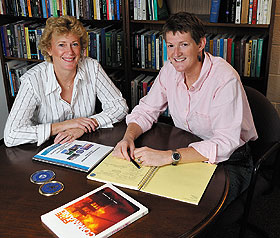  |
| HOME | THIS ISSUE | CALENDAR | GRANTS | BACK ISSUES | < BACK | NEXT > |
Public policy experts to evaluate perceptions of disaster riskby Cindy Weiss - September 15, 2008
|
||||
| The Department of Public Policy (DPP) in the College of Liberal Arts and Sciences is expanding its homeland security research with a new six-year project to evaluate how people perceive disaster risk and how their perceptions affect preparedness. Ultimately, the research will help identify citizen and public decision-maker strategies that would be effective in preparing for natural disasters such as hurricanes, tornadoes, floods, earthquakes, droughts, and wildfires, says Amy Donahue, associate professor and head of the Department of Public Policy. A former firefighter herself, Donahue is the principal investigator on the study, “Risk Perceptions, Preferences, and Preparedness,” which is funded by a $566,000 grant from the Department of Homeland Security (DHS). Public policy faculty members Mark Robbins and Bill Simonsen are also involved in the project. It is part of a larger research effort, a DHS Center of Excellence on natural disasters, coastal infrastructure, and emergency management that is based at the University of North Carolina-Chapel Hill and Jackson State University. The purpose of the Center is to improve the nation’s capability to deal with natural disasters and to find new approaches to coastal hazard planning, communications, and response. The public policy investigators at UConn, headed by Robbins, recently finished a complex study for the DHS based on responses from more than 2,600 people. Using focus groups and telephone calls, it assessed their attitudes and preferences regarding homeland security prevention, detection, and response technologies. It focused on responses to a potential terrorist attack and on how much citizens would be willing to pay in additional taxes for anti-terrorism services. The new study will measure what people consider and will tolerate when faced with natural disaster preparation, says project manager Candace Fitzpatrick, who received her master’s of public administration degree from the department in 2006 and who worked on the earlier study. “It will allow us to compare perceptions of risk and associated behavior across different segments of society so that preparedness approaches can be tailored,” she says. The research will compare the risk perceptions and preparedness actions of coastal and inland residents and decision makers. Citizen responses will be gauged over time, to see whether people change their risk perception and preparedness. First on the list of DHS topics of interest are natural hazards such as flooding from hurricanes or storm surges. Among the questions the UConn researchers will ask is how “at risk” people believe they are. “We are trying to gain a deeper understanding about how citizens understand risks and how they respond to them, by moving beyond existing research,” says Donahue.
“We hope to get at the subtleties of who citizens think are at risk, what they think the magnitude of consequences might be, how persistent the effects of a disaster are, and how long they think it would take them to ‘bounce back.’” Adds Fitzpatrick, “We are also likely to use a framework that will allow us to get a better sense of what citizens are actually willing to pay and do for preparedness.” Three random national surveys of citizens will be done, as well as surveys of 400 town and city managers and public decision makers. Fitzpatrick is a former elected official herself, having served 15 years on the Simsbury Board of Selectmen and Board of Finance. The data will be compared and contrasted, the citizen surveys repeated, and the information analyzed and used by the DHS in developing municipal and citizen preparedness policies. “We do know that citizen preparedness is very low,” says Fitzpatrick. The federal agency will want to see how and whether it should invest more at the regional and local levels, she adds. Once the effect of risk perception is understood, it will want to see whether it can use that knowledge to implement policies, and whether they should be the same or different for ‘high risk’ and ‘low risk’ locations. Donahue brings considerable disaster management expertise to the project. On a sabbatical leave last year at Louisiana State University, she served as interim director of LSU’s new Stevenson Disaster Management Institute. She is a former senior adviser for homeland security to the administrator of the National Aeronautics and Space Administration. Robbins and Simonsen specialize in public finance and policy and citizen participation techniques. Robbins is a former department head of DPP and is a member of the Government Accounting Standards Advisory Council. Simonsen recently was elected to the executive committee for the Association for Budgeting and Financial Management, the premier professional academic association for finance and budgeting. |
| ADVANCE HOME |

